Managing Operations and the Supply Chain: Circular Economy Report
VerifiedAdded on 2023/04/25
|10
|3495
|466
Report
AI Summary
This report provides a comprehensive analysis of the circular economy, examining both its theoretical underpinnings and practical applications. It begins with a description of the concept, emphasizing its goals of minimizing waste and maximizing resource utilization, and introduces the circular economy model through the example of Philips. The report then delves into the theoretical aspects, defining the circular economy and its core principles, including design thinking, product life extension, recycling, and system thinking. Key drivers such as policy, economics, health, and societal factors are discussed. The importance of the circular model is highlighted, along with its environmental, social, and economic benefits. The role of the circular supply chain in supporting the circular economy is also examined. Finally, the report provides practical examples, including Philips' initiatives with LED lighting and healthcare products, and discusses the benefits of adopting the circular economy, such as reduced costs, increased efficiency, and sustainability.
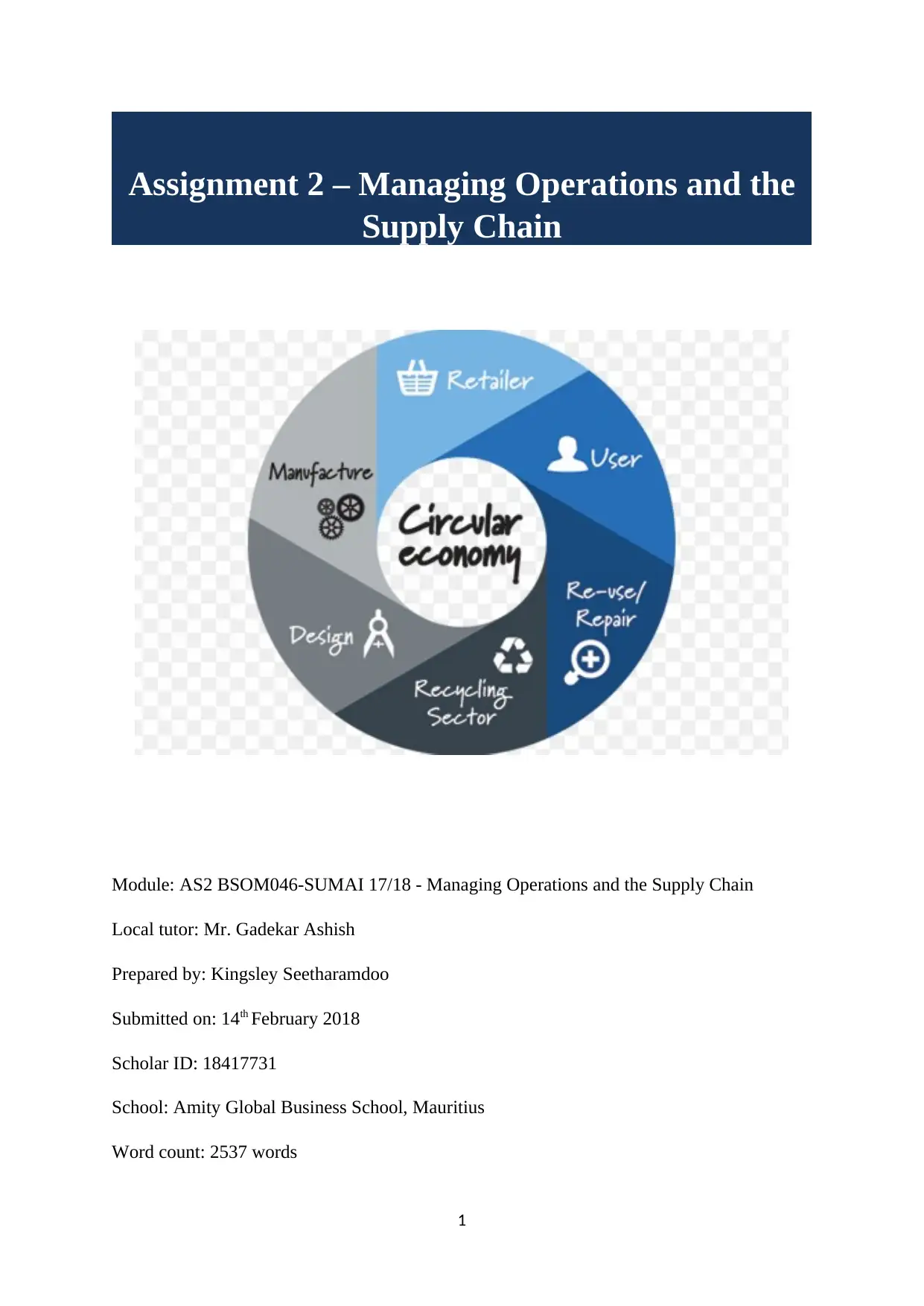
Assignment 2 – Managing Operations and the
Supply Chain
Module: AS2 BSOM046-SUMAI 17/18 - Managing Operations and the Supply Chain
Local tutor: Mr. Gadekar Ashish
Prepared by: Kingsley Seetharamdoo
Submitted on: 14th February 2018
Scholar ID: 18417731
School: Amity Global Business School, Mauritius
Word count: 2537 words
1
Supply Chain
Module: AS2 BSOM046-SUMAI 17/18 - Managing Operations and the Supply Chain
Local tutor: Mr. Gadekar Ashish
Prepared by: Kingsley Seetharamdoo
Submitted on: 14th February 2018
Scholar ID: 18417731
School: Amity Global Business School, Mauritius
Word count: 2537 words
1
Paraphrase This Document
Need a fresh take? Get an instant paraphrase of this document with our AI Paraphraser
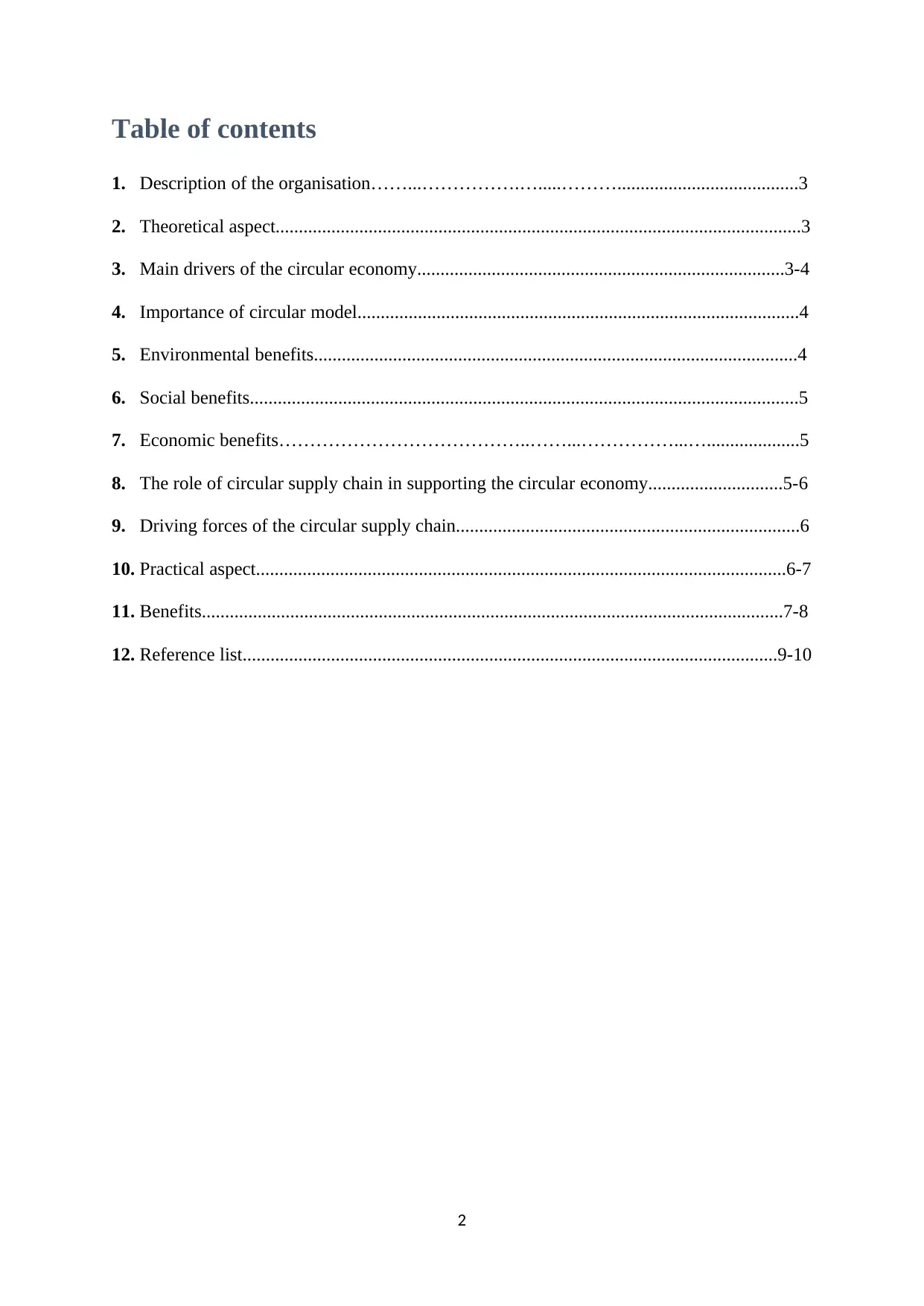
Table of contents
1. Description of the organisation……...…………….….....……….......................................3
2. Theoretical aspect.................................................................................................................3
3. Main drivers of the circular economy...............................................................................3-4
4. Importance of circular model...............................................................................................4
5. Environmental benefits........................................................................................................4
6. Social benefits......................................................................................................................5
7. Economic benefits…………………………………..……...……………...…....................5
8. The role of circular supply chain in supporting the circular economy.............................5-6
9. Driving forces of the circular supply chain..........................................................................6
10. Practical aspect..................................................................................................................6-7
11. Benefits.............................................................................................................................7-8
12. Reference list...................................................................................................................9-10
2
1. Description of the organisation……...…………….….....……….......................................3
2. Theoretical aspect.................................................................................................................3
3. Main drivers of the circular economy...............................................................................3-4
4. Importance of circular model...............................................................................................4
5. Environmental benefits........................................................................................................4
6. Social benefits......................................................................................................................5
7. Economic benefits…………………………………..……...……………...…....................5
8. The role of circular supply chain in supporting the circular economy.............................5-6
9. Driving forces of the circular supply chain..........................................................................6
10. Practical aspect..................................................................................................................6-7
11. Benefits.............................................................................................................................7-8
12. Reference list...................................................................................................................9-10
2
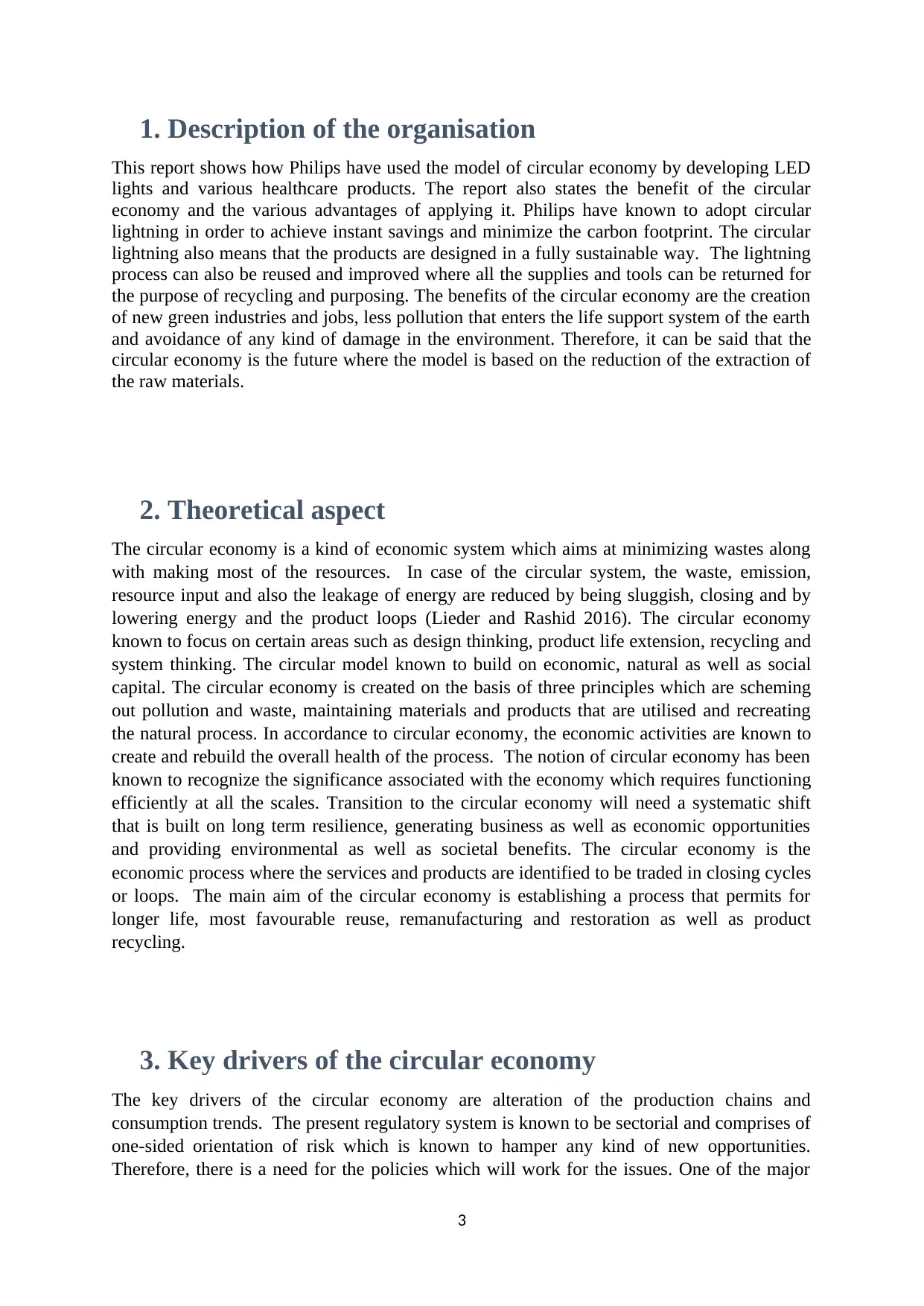
1. Description of the organisation
This report shows how Philips have used the model of circular economy by developing LED
lights and various healthcare products. The report also states the benefit of the circular
economy and the various advantages of applying it. Philips have known to adopt circular
lightning in order to achieve instant savings and minimize the carbon footprint. The circular
lightning also means that the products are designed in a fully sustainable way. The lightning
process can also be reused and improved where all the supplies and tools can be returned for
the purpose of recycling and purposing. The benefits of the circular economy are the creation
of new green industries and jobs, less pollution that enters the life support system of the earth
and avoidance of any kind of damage in the environment. Therefore, it can be said that the
circular economy is the future where the model is based on the reduction of the extraction of
the raw materials.
2. Theoretical aspect
The circular economy is a kind of economic system which aims at minimizing wastes along
with making most of the resources. In case of the circular system, the waste, emission,
resource input and also the leakage of energy are reduced by being sluggish, closing and by
lowering energy and the product loops (Lieder and Rashid 2016). The circular economy
known to focus on certain areas such as design thinking, product life extension, recycling and
system thinking. The circular model known to build on economic, natural as well as social
capital. The circular economy is created on the basis of three principles which are scheming
out pollution and waste, maintaining materials and products that are utilised and recreating
the natural process. In accordance to circular economy, the economic activities are known to
create and rebuild the overall health of the process. The notion of circular economy has been
known to recognize the significance associated with the economy which requires functioning
efficiently at all the scales. Transition to the circular economy will need a systematic shift
that is built on long term resilience, generating business as well as economic opportunities
and providing environmental as well as societal benefits. The circular economy is the
economic process where the services and products are identified to be traded in closing cycles
or loops. The main aim of the circular economy is establishing a process that permits for
longer life, most favourable reuse, remanufacturing and restoration as well as product
recycling.
3. Key drivers of the circular economy
The key drivers of the circular economy are alteration of the production chains and
consumption trends. The present regulatory system is known to be sectorial and comprises of
one-sided orientation of risk which is known to hamper any kind of new opportunities.
Therefore, there is a need for the policies which will work for the issues. One of the major
3
This report shows how Philips have used the model of circular economy by developing LED
lights and various healthcare products. The report also states the benefit of the circular
economy and the various advantages of applying it. Philips have known to adopt circular
lightning in order to achieve instant savings and minimize the carbon footprint. The circular
lightning also means that the products are designed in a fully sustainable way. The lightning
process can also be reused and improved where all the supplies and tools can be returned for
the purpose of recycling and purposing. The benefits of the circular economy are the creation
of new green industries and jobs, less pollution that enters the life support system of the earth
and avoidance of any kind of damage in the environment. Therefore, it can be said that the
circular economy is the future where the model is based on the reduction of the extraction of
the raw materials.
2. Theoretical aspect
The circular economy is a kind of economic system which aims at minimizing wastes along
with making most of the resources. In case of the circular system, the waste, emission,
resource input and also the leakage of energy are reduced by being sluggish, closing and by
lowering energy and the product loops (Lieder and Rashid 2016). The circular economy
known to focus on certain areas such as design thinking, product life extension, recycling and
system thinking. The circular model known to build on economic, natural as well as social
capital. The circular economy is created on the basis of three principles which are scheming
out pollution and waste, maintaining materials and products that are utilised and recreating
the natural process. In accordance to circular economy, the economic activities are known to
create and rebuild the overall health of the process. The notion of circular economy has been
known to recognize the significance associated with the economy which requires functioning
efficiently at all the scales. Transition to the circular economy will need a systematic shift
that is built on long term resilience, generating business as well as economic opportunities
and providing environmental as well as societal benefits. The circular economy is the
economic process where the services and products are identified to be traded in closing cycles
or loops. The main aim of the circular economy is establishing a process that permits for
longer life, most favourable reuse, remanufacturing and restoration as well as product
recycling.
3. Key drivers of the circular economy
The key drivers of the circular economy are alteration of the production chains and
consumption trends. The present regulatory system is known to be sectorial and comprises of
one-sided orientation of risk which is known to hamper any kind of new opportunities.
Therefore, there is a need for the policies which will work for the issues. One of the major
3
⊘ This is a preview!⊘
Do you want full access?
Subscribe today to unlock all pages.

Trusted by 1+ million students worldwide
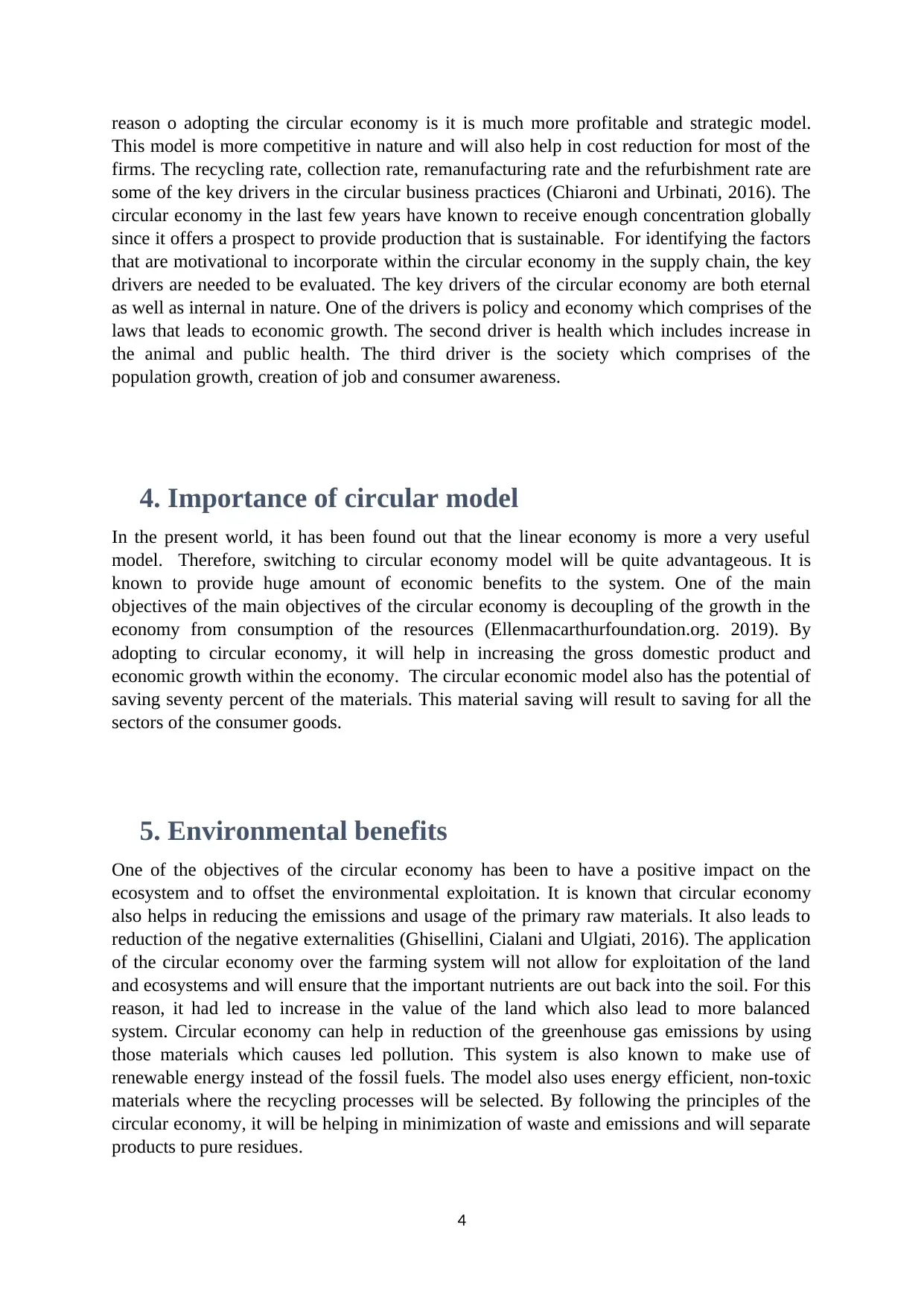
reason o adopting the circular economy is it is much more profitable and strategic model.
This model is more competitive in nature and will also help in cost reduction for most of the
firms. The recycling rate, collection rate, remanufacturing rate and the refurbishment rate are
some of the key drivers in the circular business practices (Chiaroni and Urbinati, 2016). The
circular economy in the last few years have known to receive enough concentration globally
since it offers a prospect to provide production that is sustainable. For identifying the factors
that are motivational to incorporate within the circular economy in the supply chain, the key
drivers are needed to be evaluated. The key drivers of the circular economy are both eternal
as well as internal in nature. One of the drivers is policy and economy which comprises of the
laws that leads to economic growth. The second driver is health which includes increase in
the animal and public health. The third driver is the society which comprises of the
population growth, creation of job and consumer awareness.
4. Importance of circular model
In the present world, it has been found out that the linear economy is more a very useful
model. Therefore, switching to circular economy model will be quite advantageous. It is
known to provide huge amount of economic benefits to the system. One of the main
objectives of the main objectives of the circular economy is decoupling of the growth in the
economy from consumption of the resources (Ellenmacarthurfoundation.org. 2019). By
adopting to circular economy, it will help in increasing the gross domestic product and
economic growth within the economy. The circular economic model also has the potential of
saving seventy percent of the materials. This material saving will result to saving for all the
sectors of the consumer goods.
5. Environmental benefits
One of the objectives of the circular economy has been to have a positive impact on the
ecosystem and to offset the environmental exploitation. It is known that circular economy
also helps in reducing the emissions and usage of the primary raw materials. It also leads to
reduction of the negative externalities (Ghisellini, Cialani and Ulgiati, 2016). The application
of the circular economy over the farming system will not allow for exploitation of the land
and ecosystems and will ensure that the important nutrients are out back into the soil. For this
reason, it had led to increase in the value of the land which also lead to more balanced
system. Circular economy can help in reduction of the greenhouse gas emissions by using
those materials which causes led pollution. This system is also known to make use of
renewable energy instead of the fossil fuels. The model also uses energy efficient, non-toxic
materials where the recycling processes will be selected. By following the principles of the
circular economy, it will be helping in minimization of waste and emissions and will separate
products to pure residues.
4
This model is more competitive in nature and will also help in cost reduction for most of the
firms. The recycling rate, collection rate, remanufacturing rate and the refurbishment rate are
some of the key drivers in the circular business practices (Chiaroni and Urbinati, 2016). The
circular economy in the last few years have known to receive enough concentration globally
since it offers a prospect to provide production that is sustainable. For identifying the factors
that are motivational to incorporate within the circular economy in the supply chain, the key
drivers are needed to be evaluated. The key drivers of the circular economy are both eternal
as well as internal in nature. One of the drivers is policy and economy which comprises of the
laws that leads to economic growth. The second driver is health which includes increase in
the animal and public health. The third driver is the society which comprises of the
population growth, creation of job and consumer awareness.
4. Importance of circular model
In the present world, it has been found out that the linear economy is more a very useful
model. Therefore, switching to circular economy model will be quite advantageous. It is
known to provide huge amount of economic benefits to the system. One of the main
objectives of the main objectives of the circular economy is decoupling of the growth in the
economy from consumption of the resources (Ellenmacarthurfoundation.org. 2019). By
adopting to circular economy, it will help in increasing the gross domestic product and
economic growth within the economy. The circular economic model also has the potential of
saving seventy percent of the materials. This material saving will result to saving for all the
sectors of the consumer goods.
5. Environmental benefits
One of the objectives of the circular economy has been to have a positive impact on the
ecosystem and to offset the environmental exploitation. It is known that circular economy
also helps in reducing the emissions and usage of the primary raw materials. It also leads to
reduction of the negative externalities (Ghisellini, Cialani and Ulgiati, 2016). The application
of the circular economy over the farming system will not allow for exploitation of the land
and ecosystems and will ensure that the important nutrients are out back into the soil. For this
reason, it had led to increase in the value of the land which also lead to more balanced
system. Circular economy can help in reduction of the greenhouse gas emissions by using
those materials which causes led pollution. This system is also known to make use of
renewable energy instead of the fossil fuels. The model also uses energy efficient, non-toxic
materials where the recycling processes will be selected. By following the principles of the
circular economy, it will be helping in minimization of waste and emissions and will separate
products to pure residues.
4
Paraphrase This Document
Need a fresh take? Get an instant paraphrase of this document with our AI Paraphraser
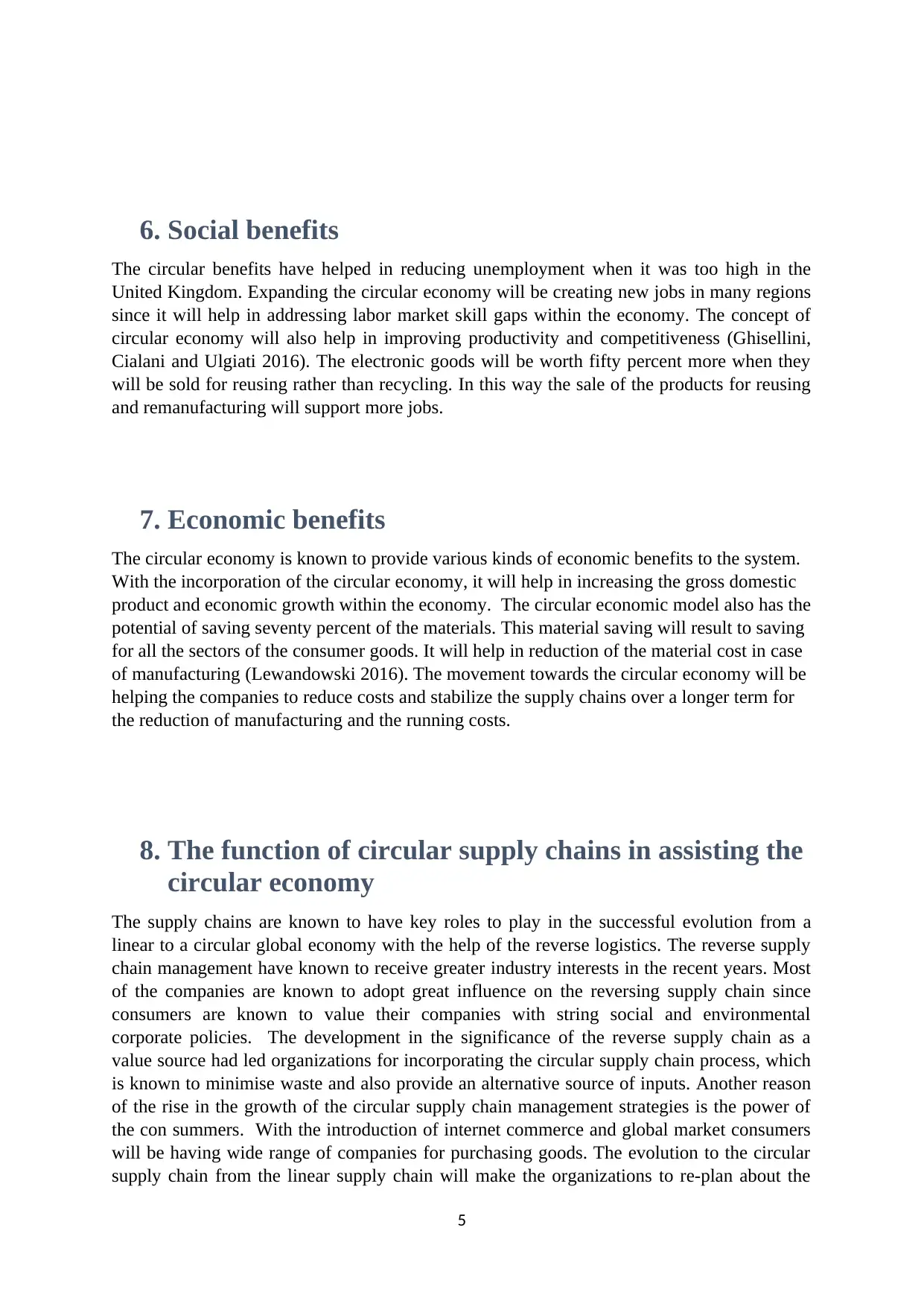
6. Social benefits
The circular benefits have helped in reducing unemployment when it was too high in the
United Kingdom. Expanding the circular economy will be creating new jobs in many regions
since it will help in addressing labor market skill gaps within the economy. The concept of
circular economy will also help in improving productivity and competitiveness (Ghisellini,
Cialani and Ulgiati 2016). The electronic goods will be worth fifty percent more when they
will be sold for reusing rather than recycling. In this way the sale of the products for reusing
and remanufacturing will support more jobs.
7. Economic benefits
The circular economy is known to provide various kinds of economic benefits to the system.
With the incorporation of the circular economy, it will help in increasing the gross domestic
product and economic growth within the economy. The circular economic model also has the
potential of saving seventy percent of the materials. This material saving will result to saving
for all the sectors of the consumer goods. It will help in reduction of the material cost in case
of manufacturing (Lewandowski 2016). The movement towards the circular economy will be
helping the companies to reduce costs and stabilize the supply chains over a longer term for
the reduction of manufacturing and the running costs.
8. The function of circular supply chains in assisting the
circular economy
The supply chains are known to have key roles to play in the successful evolution from a
linear to a circular global economy with the help of the reverse logistics. The reverse supply
chain management have known to receive greater industry interests in the recent years. Most
of the companies are known to adopt great influence on the reversing supply chain since
consumers are known to value their companies with string social and environmental
corporate policies. The development in the significance of the reverse supply chain as a
value source had led organizations for incorporating the circular supply chain process, which
is known to minimise waste and also provide an alternative source of inputs. Another reason
of the rise in the growth of the circular supply chain management strategies is the power of
the con summers. With the introduction of internet commerce and global market consumers
will be having wide range of companies for purchasing goods. The evolution to the circular
supply chain from the linear supply chain will make the organizations to re-plan about the
5
The circular benefits have helped in reducing unemployment when it was too high in the
United Kingdom. Expanding the circular economy will be creating new jobs in many regions
since it will help in addressing labor market skill gaps within the economy. The concept of
circular economy will also help in improving productivity and competitiveness (Ghisellini,
Cialani and Ulgiati 2016). The electronic goods will be worth fifty percent more when they
will be sold for reusing rather than recycling. In this way the sale of the products for reusing
and remanufacturing will support more jobs.
7. Economic benefits
The circular economy is known to provide various kinds of economic benefits to the system.
With the incorporation of the circular economy, it will help in increasing the gross domestic
product and economic growth within the economy. The circular economic model also has the
potential of saving seventy percent of the materials. This material saving will result to saving
for all the sectors of the consumer goods. It will help in reduction of the material cost in case
of manufacturing (Lewandowski 2016). The movement towards the circular economy will be
helping the companies to reduce costs and stabilize the supply chains over a longer term for
the reduction of manufacturing and the running costs.
8. The function of circular supply chains in assisting the
circular economy
The supply chains are known to have key roles to play in the successful evolution from a
linear to a circular global economy with the help of the reverse logistics. The reverse supply
chain management have known to receive greater industry interests in the recent years. Most
of the companies are known to adopt great influence on the reversing supply chain since
consumers are known to value their companies with string social and environmental
corporate policies. The development in the significance of the reverse supply chain as a
value source had led organizations for incorporating the circular supply chain process, which
is known to minimise waste and also provide an alternative source of inputs. Another reason
of the rise in the growth of the circular supply chain management strategies is the power of
the con summers. With the introduction of internet commerce and global market consumers
will be having wide range of companies for purchasing goods. The evolution to the circular
supply chain from the linear supply chain will make the organizations to re-plan about the
5
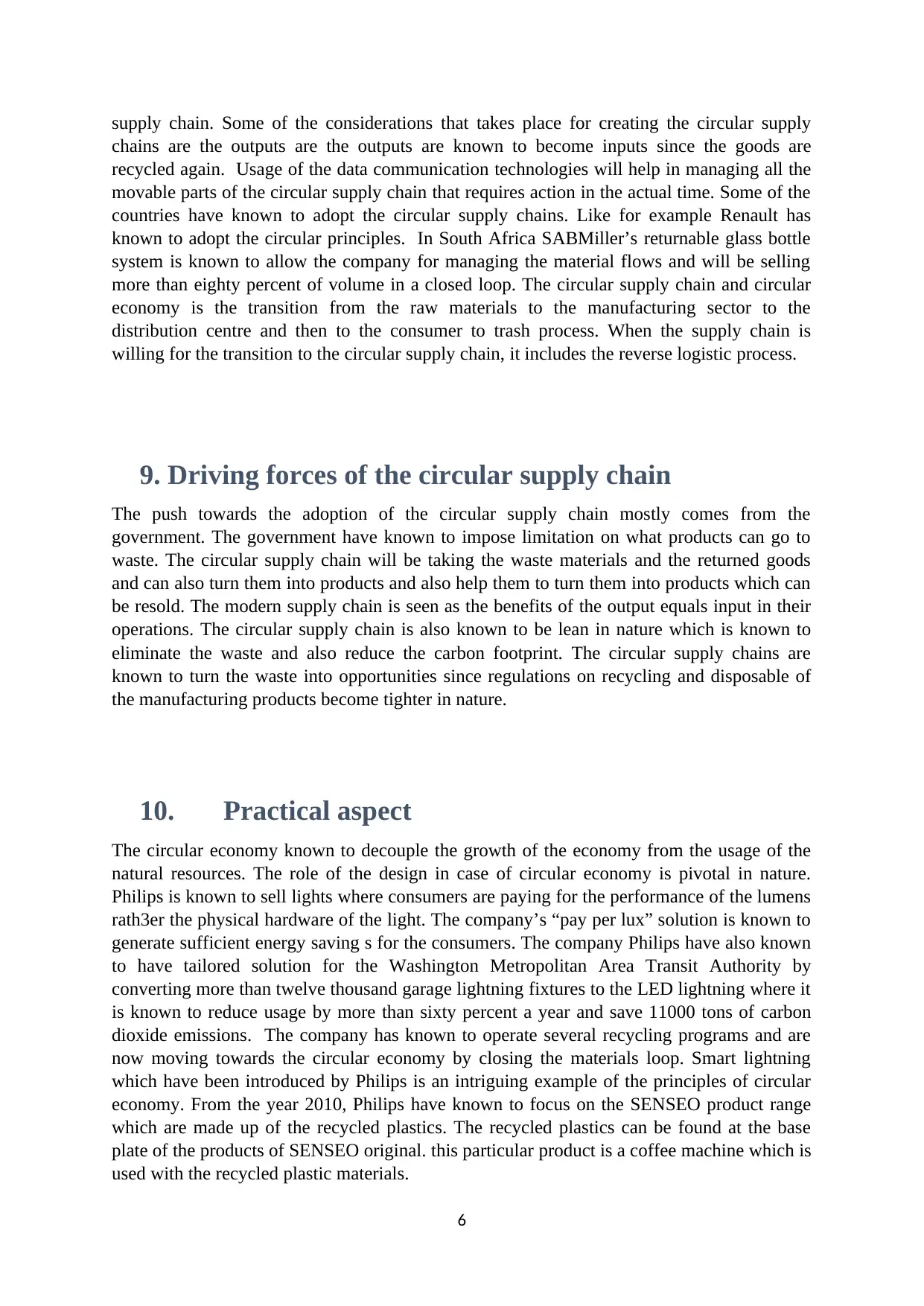
supply chain. Some of the considerations that takes place for creating the circular supply
chains are the outputs are the outputs are known to become inputs since the goods are
recycled again. Usage of the data communication technologies will help in managing all the
movable parts of the circular supply chain that requires action in the actual time. Some of the
countries have known to adopt the circular supply chains. Like for example Renault has
known to adopt the circular principles. In South Africa SABMiller’s returnable glass bottle
system is known to allow the company for managing the material flows and will be selling
more than eighty percent of volume in a closed loop. The circular supply chain and circular
economy is the transition from the raw materials to the manufacturing sector to the
distribution centre and then to the consumer to trash process. When the supply chain is
willing for the transition to the circular supply chain, it includes the reverse logistic process.
9. Driving forces of the circular supply chain
The push towards the adoption of the circular supply chain mostly comes from the
government. The government have known to impose limitation on what products can go to
waste. The circular supply chain will be taking the waste materials and the returned goods
and can also turn them into products and also help them to turn them into products which can
be resold. The modern supply chain is seen as the benefits of the output equals input in their
operations. The circular supply chain is also known to be lean in nature which is known to
eliminate the waste and also reduce the carbon footprint. The circular supply chains are
known to turn the waste into opportunities since regulations on recycling and disposable of
the manufacturing products become tighter in nature.
10. Practical aspect
The circular economy known to decouple the growth of the economy from the usage of the
natural resources. The role of the design in case of circular economy is pivotal in nature.
Philips is known to sell lights where consumers are paying for the performance of the lumens
rath3er the physical hardware of the light. The company’s “pay per lux” solution is known to
generate sufficient energy saving s for the consumers. The company Philips have also known
to have tailored solution for the Washington Metropolitan Area Transit Authority by
converting more than twelve thousand garage lightning fixtures to the LED lightning where it
is known to reduce usage by more than sixty percent a year and save 11000 tons of carbon
dioxide emissions. The company has known to operate several recycling programs and are
now moving towards the circular economy by closing the materials loop. Smart lightning
which have been introduced by Philips is an intriguing example of the principles of circular
economy. From the year 2010, Philips have known to focus on the SENSEO product range
which are made up of the recycled plastics. The recycled plastics can be found at the base
plate of the products of SENSEO original. this particular product is a coffee machine which is
used with the recycled plastic materials.
6
chains are the outputs are the outputs are known to become inputs since the goods are
recycled again. Usage of the data communication technologies will help in managing all the
movable parts of the circular supply chain that requires action in the actual time. Some of the
countries have known to adopt the circular supply chains. Like for example Renault has
known to adopt the circular principles. In South Africa SABMiller’s returnable glass bottle
system is known to allow the company for managing the material flows and will be selling
more than eighty percent of volume in a closed loop. The circular supply chain and circular
economy is the transition from the raw materials to the manufacturing sector to the
distribution centre and then to the consumer to trash process. When the supply chain is
willing for the transition to the circular supply chain, it includes the reverse logistic process.
9. Driving forces of the circular supply chain
The push towards the adoption of the circular supply chain mostly comes from the
government. The government have known to impose limitation on what products can go to
waste. The circular supply chain will be taking the waste materials and the returned goods
and can also turn them into products and also help them to turn them into products which can
be resold. The modern supply chain is seen as the benefits of the output equals input in their
operations. The circular supply chain is also known to be lean in nature which is known to
eliminate the waste and also reduce the carbon footprint. The circular supply chains are
known to turn the waste into opportunities since regulations on recycling and disposable of
the manufacturing products become tighter in nature.
10. Practical aspect
The circular economy known to decouple the growth of the economy from the usage of the
natural resources. The role of the design in case of circular economy is pivotal in nature.
Philips is known to sell lights where consumers are paying for the performance of the lumens
rath3er the physical hardware of the light. The company’s “pay per lux” solution is known to
generate sufficient energy saving s for the consumers. The company Philips have also known
to have tailored solution for the Washington Metropolitan Area Transit Authority by
converting more than twelve thousand garage lightning fixtures to the LED lightning where it
is known to reduce usage by more than sixty percent a year and save 11000 tons of carbon
dioxide emissions. The company has known to operate several recycling programs and are
now moving towards the circular economy by closing the materials loop. Smart lightning
which have been introduced by Philips is an intriguing example of the principles of circular
economy. From the year 2010, Philips have known to focus on the SENSEO product range
which are made up of the recycled plastics. The recycled plastics can be found at the base
plate of the products of SENSEO original. this particular product is a coffee machine which is
used with the recycled plastic materials.
6
⊘ This is a preview!⊘
Do you want full access?
Subscribe today to unlock all pages.

Trusted by 1+ million students worldwide
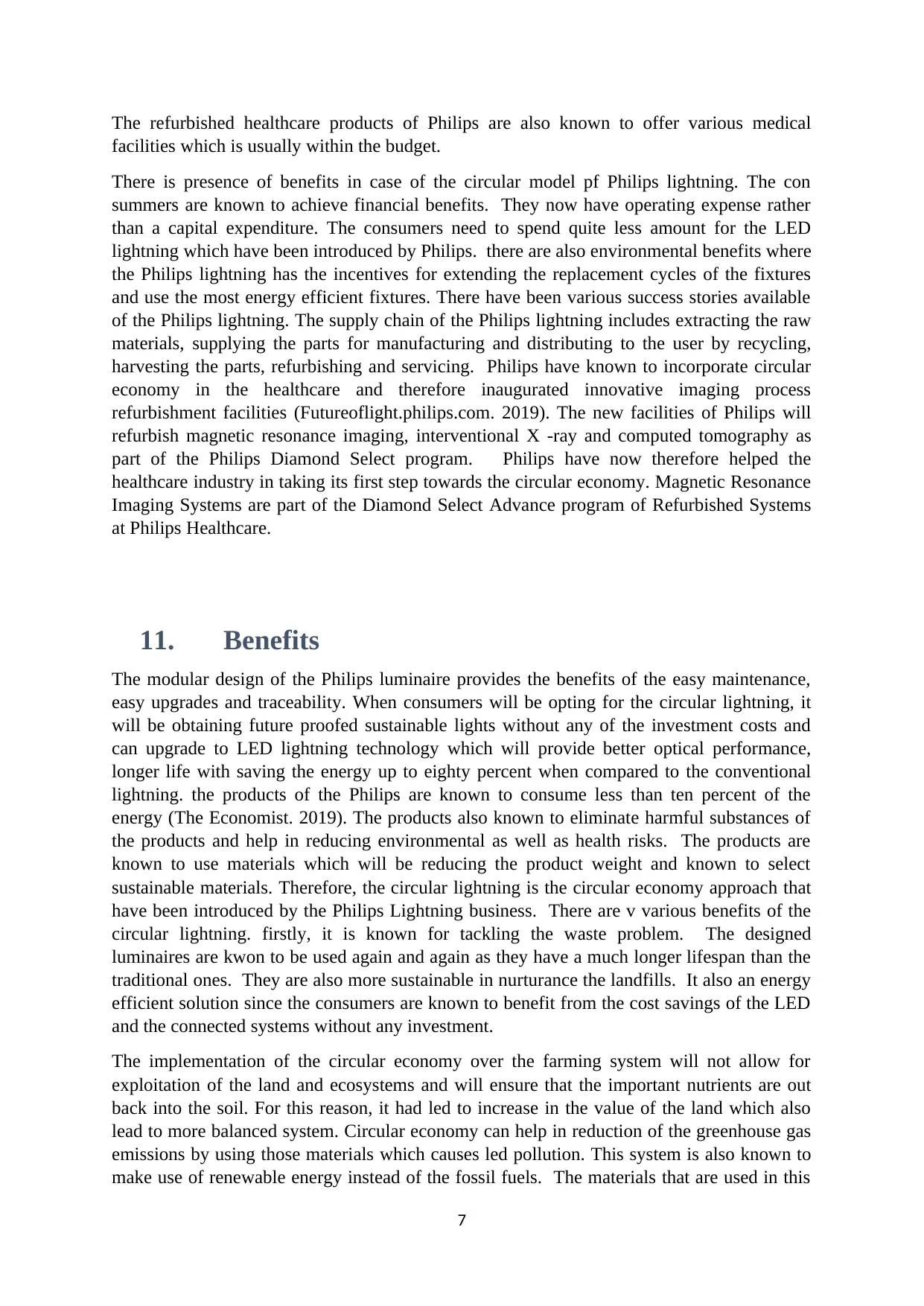
The refurbished healthcare products of Philips are also known to offer various medical
facilities which is usually within the budget.
There is presence of benefits in case of the circular model pf Philips lightning. The con
summers are known to achieve financial benefits. They now have operating expense rather
than a capital expenditure. The consumers need to spend quite less amount for the LED
lightning which have been introduced by Philips. there are also environmental benefits where
the Philips lightning has the incentives for extending the replacement cycles of the fixtures
and use the most energy efficient fixtures. There have been various success stories available
of the Philips lightning. The supply chain of the Philips lightning includes extracting the raw
materials, supplying the parts for manufacturing and distributing to the user by recycling,
harvesting the parts, refurbishing and servicing. Philips have known to incorporate circular
economy in the healthcare and therefore inaugurated innovative imaging process
refurbishment facilities (Futureoflight.philips.com. 2019). The new facilities of Philips will
refurbish magnetic resonance imaging, interventional X -ray and computed tomography as
part of the Philips Diamond Select program. Philips have now therefore helped the
healthcare industry in taking its first step towards the circular economy. Magnetic Resonance
Imaging Systems are part of the Diamond Select Advance program of Refurbished Systems
at Philips Healthcare.
11. Benefits
The modular design of the Philips luminaire provides the benefits of the easy maintenance,
easy upgrades and traceability. When consumers will be opting for the circular lightning, it
will be obtaining future proofed sustainable lights without any of the investment costs and
can upgrade to LED lightning technology which will provide better optical performance,
longer life with saving the energy up to eighty percent when compared to the conventional
lightning. the products of the Philips are known to consume less than ten percent of the
energy (The Economist. 2019). The products also known to eliminate harmful substances of
the products and help in reducing environmental as well as health risks. The products are
known to use materials which will be reducing the product weight and known to select
sustainable materials. Therefore, the circular lightning is the circular economy approach that
have been introduced by the Philips Lightning business. There are v various benefits of the
circular lightning. firstly, it is known for tackling the waste problem. The designed
luminaires are kwon to be used again and again as they have a much longer lifespan than the
traditional ones. They are also more sustainable in nurturance the landfills. It also an energy
efficient solution since the consumers are known to benefit from the cost savings of the LED
and the connected systems without any investment.
The implementation of the circular economy over the farming system will not allow for
exploitation of the land and ecosystems and will ensure that the important nutrients are out
back into the soil. For this reason, it had led to increase in the value of the land which also
lead to more balanced system. Circular economy can help in reduction of the greenhouse gas
emissions by using those materials which causes led pollution. This system is also known to
make use of renewable energy instead of the fossil fuels. The materials that are used in this
7
facilities which is usually within the budget.
There is presence of benefits in case of the circular model pf Philips lightning. The con
summers are known to achieve financial benefits. They now have operating expense rather
than a capital expenditure. The consumers need to spend quite less amount for the LED
lightning which have been introduced by Philips. there are also environmental benefits where
the Philips lightning has the incentives for extending the replacement cycles of the fixtures
and use the most energy efficient fixtures. There have been various success stories available
of the Philips lightning. The supply chain of the Philips lightning includes extracting the raw
materials, supplying the parts for manufacturing and distributing to the user by recycling,
harvesting the parts, refurbishing and servicing. Philips have known to incorporate circular
economy in the healthcare and therefore inaugurated innovative imaging process
refurbishment facilities (Futureoflight.philips.com. 2019). The new facilities of Philips will
refurbish magnetic resonance imaging, interventional X -ray and computed tomography as
part of the Philips Diamond Select program. Philips have now therefore helped the
healthcare industry in taking its first step towards the circular economy. Magnetic Resonance
Imaging Systems are part of the Diamond Select Advance program of Refurbished Systems
at Philips Healthcare.
11. Benefits
The modular design of the Philips luminaire provides the benefits of the easy maintenance,
easy upgrades and traceability. When consumers will be opting for the circular lightning, it
will be obtaining future proofed sustainable lights without any of the investment costs and
can upgrade to LED lightning technology which will provide better optical performance,
longer life with saving the energy up to eighty percent when compared to the conventional
lightning. the products of the Philips are known to consume less than ten percent of the
energy (The Economist. 2019). The products also known to eliminate harmful substances of
the products and help in reducing environmental as well as health risks. The products are
known to use materials which will be reducing the product weight and known to select
sustainable materials. Therefore, the circular lightning is the circular economy approach that
have been introduced by the Philips Lightning business. There are v various benefits of the
circular lightning. firstly, it is known for tackling the waste problem. The designed
luminaires are kwon to be used again and again as they have a much longer lifespan than the
traditional ones. They are also more sustainable in nurturance the landfills. It also an energy
efficient solution since the consumers are known to benefit from the cost savings of the LED
and the connected systems without any investment.
The implementation of the circular economy over the farming system will not allow for
exploitation of the land and ecosystems and will ensure that the important nutrients are out
back into the soil. For this reason, it had led to increase in the value of the land which also
lead to more balanced system. Circular economy can help in reduction of the greenhouse gas
emissions by using those materials which causes led pollution. This system is also known to
make use of renewable energy instead of the fossil fuels. The materials that are used in this
7
Paraphrase This Document
Need a fresh take? Get an instant paraphrase of this document with our AI Paraphraser
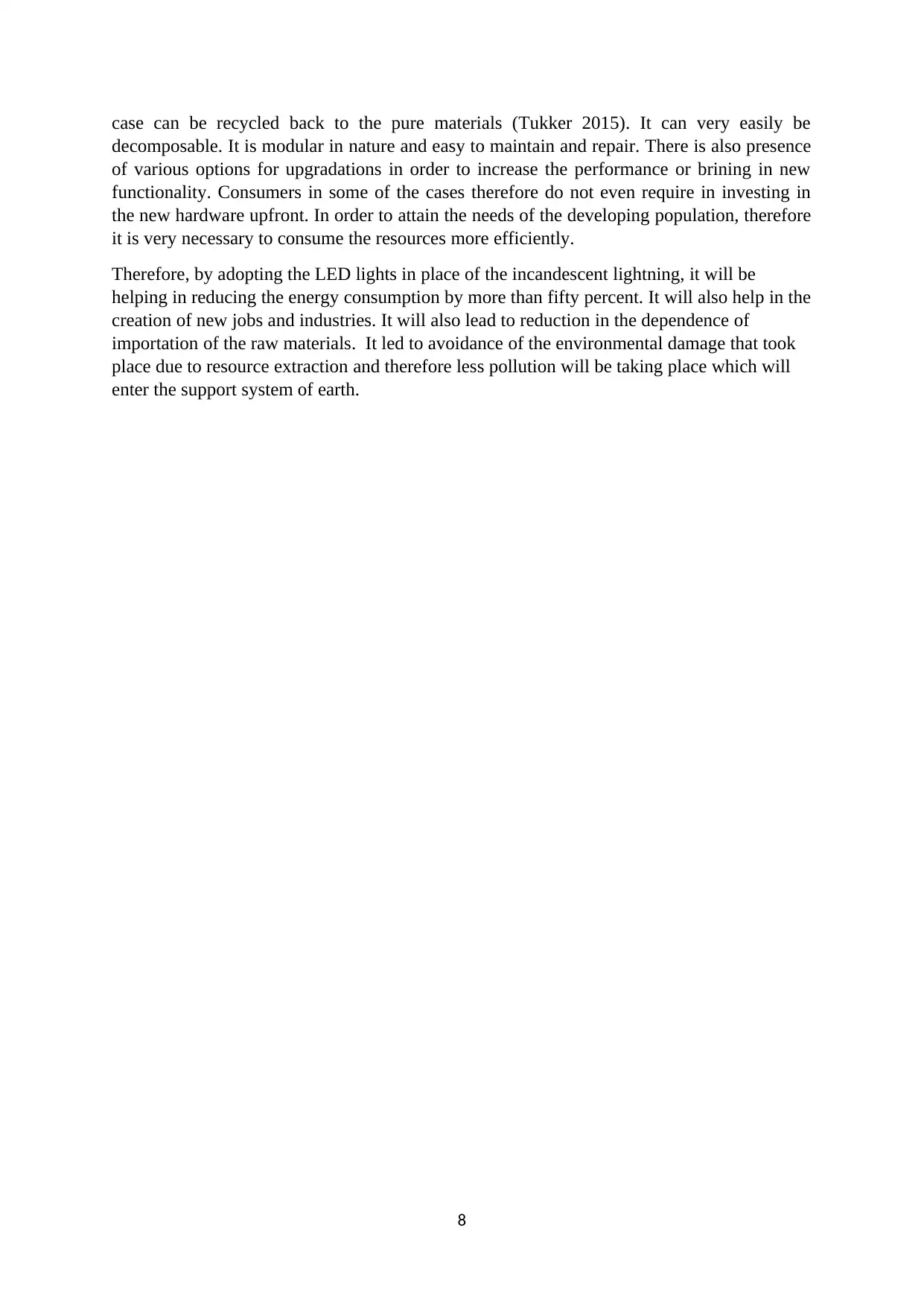
case can be recycled back to the pure materials (Tukker 2015). It can very easily be
decomposable. It is modular in nature and easy to maintain and repair. There is also presence
of various options for upgradations in order to increase the performance or brining in new
functionality. Consumers in some of the cases therefore do not even require in investing in
the new hardware upfront. In order to attain the needs of the developing population, therefore
it is very necessary to consume the resources more efficiently.
Therefore, by adopting the LED lights in place of the incandescent lightning, it will be
helping in reducing the energy consumption by more than fifty percent. It will also help in the
creation of new jobs and industries. It will also lead to reduction in the dependence of
importation of the raw materials. It led to avoidance of the environmental damage that took
place due to resource extraction and therefore less pollution will be taking place which will
enter the support system of earth.
8
decomposable. It is modular in nature and easy to maintain and repair. There is also presence
of various options for upgradations in order to increase the performance or brining in new
functionality. Consumers in some of the cases therefore do not even require in investing in
the new hardware upfront. In order to attain the needs of the developing population, therefore
it is very necessary to consume the resources more efficiently.
Therefore, by adopting the LED lights in place of the incandescent lightning, it will be
helping in reducing the energy consumption by more than fifty percent. It will also help in the
creation of new jobs and industries. It will also lead to reduction in the dependence of
importation of the raw materials. It led to avoidance of the environmental damage that took
place due to resource extraction and therefore less pollution will be taking place which will
enter the support system of earth.
8
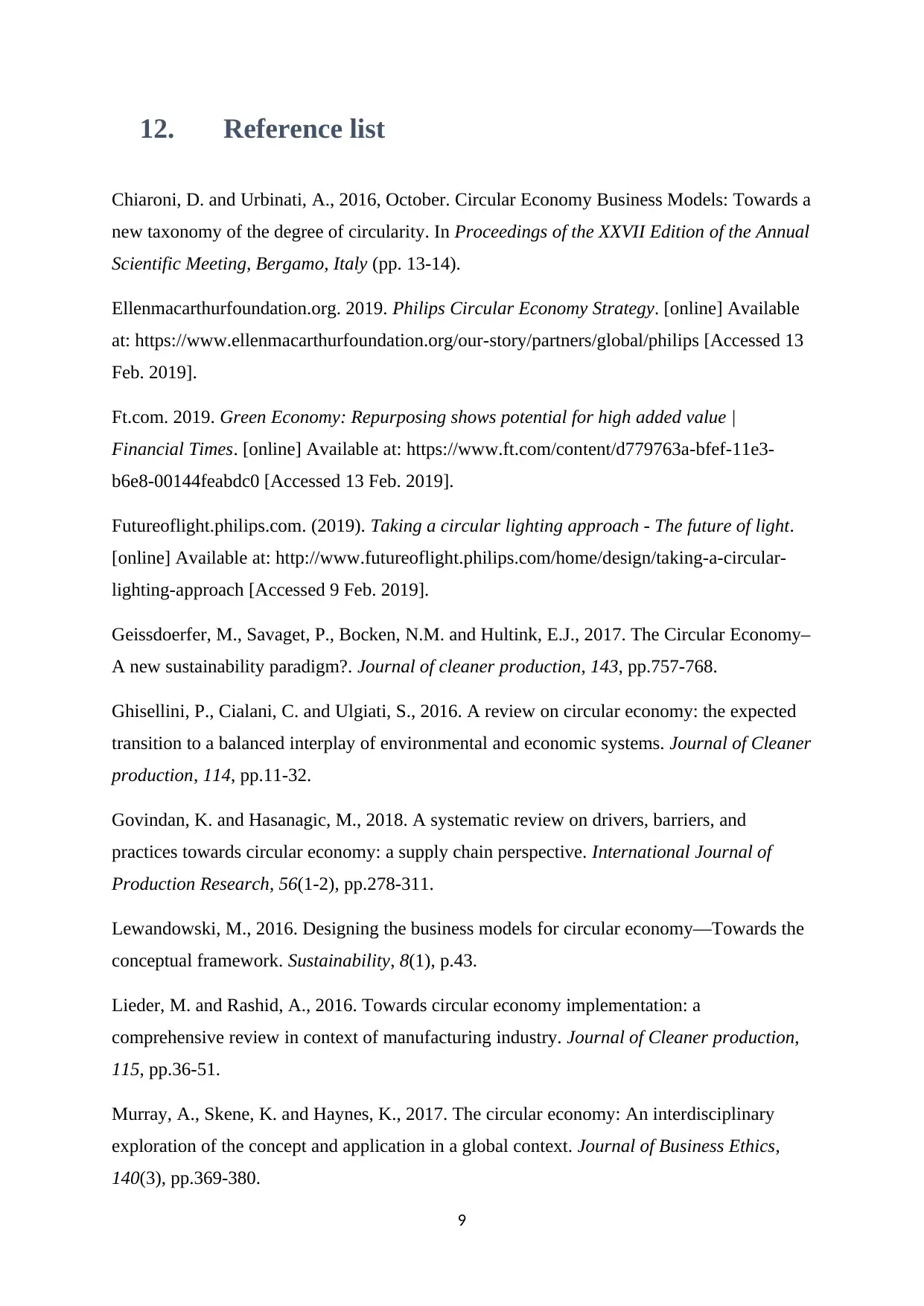
12. Reference list
Chiaroni, D. and Urbinati, A., 2016, October. Circular Economy Business Models: Towards a
new taxonomy of the degree of circularity. In Proceedings of the XXVII Edition of the Annual
Scientific Meeting, Bergamo, Italy (pp. 13-14).
Ellenmacarthurfoundation.org. 2019. Philips Circular Economy Strategy. [online] Available
at: https://www.ellenmacarthurfoundation.org/our-story/partners/global/philips [Accessed 13
Feb. 2019].
Ft.com. 2019. Green Economy: Repurposing shows potential for high added value |
Financial Times. [online] Available at: https://www.ft.com/content/d779763a-bfef-11e3-
b6e8-00144feabdc0 [Accessed 13 Feb. 2019].
Futureoflight.philips.com. (2019). Taking a circular lighting approach - The future of light.
[online] Available at: http://www.futureoflight.philips.com/home/design/taking-a-circular-
lighting-approach [Accessed 9 Feb. 2019].
Geissdoerfer, M., Savaget, P., Bocken, N.M. and Hultink, E.J., 2017. The Circular Economy–
A new sustainability paradigm?. Journal of cleaner production, 143, pp.757-768.
Ghisellini, P., Cialani, C. and Ulgiati, S., 2016. A review on circular economy: the expected
transition to a balanced interplay of environmental and economic systems. Journal of Cleaner
production, 114, pp.11-32.
Govindan, K. and Hasanagic, M., 2018. A systematic review on drivers, barriers, and
practices towards circular economy: a supply chain perspective. International Journal of
Production Research, 56(1-2), pp.278-311.
Lewandowski, M., 2016. Designing the business models for circular economy—Towards the
conceptual framework. Sustainability, 8(1), p.43.
Lieder, M. and Rashid, A., 2016. Towards circular economy implementation: a
comprehensive review in context of manufacturing industry. Journal of Cleaner production,
115, pp.36-51.
Murray, A., Skene, K. and Haynes, K., 2017. The circular economy: An interdisciplinary
exploration of the concept and application in a global context. Journal of Business Ethics,
140(3), pp.369-380.
9
Chiaroni, D. and Urbinati, A., 2016, October. Circular Economy Business Models: Towards a
new taxonomy of the degree of circularity. In Proceedings of the XXVII Edition of the Annual
Scientific Meeting, Bergamo, Italy (pp. 13-14).
Ellenmacarthurfoundation.org. 2019. Philips Circular Economy Strategy. [online] Available
at: https://www.ellenmacarthurfoundation.org/our-story/partners/global/philips [Accessed 13
Feb. 2019].
Ft.com. 2019. Green Economy: Repurposing shows potential for high added value |
Financial Times. [online] Available at: https://www.ft.com/content/d779763a-bfef-11e3-
b6e8-00144feabdc0 [Accessed 13 Feb. 2019].
Futureoflight.philips.com. (2019). Taking a circular lighting approach - The future of light.
[online] Available at: http://www.futureoflight.philips.com/home/design/taking-a-circular-
lighting-approach [Accessed 9 Feb. 2019].
Geissdoerfer, M., Savaget, P., Bocken, N.M. and Hultink, E.J., 2017. The Circular Economy–
A new sustainability paradigm?. Journal of cleaner production, 143, pp.757-768.
Ghisellini, P., Cialani, C. and Ulgiati, S., 2016. A review on circular economy: the expected
transition to a balanced interplay of environmental and economic systems. Journal of Cleaner
production, 114, pp.11-32.
Govindan, K. and Hasanagic, M., 2018. A systematic review on drivers, barriers, and
practices towards circular economy: a supply chain perspective. International Journal of
Production Research, 56(1-2), pp.278-311.
Lewandowski, M., 2016. Designing the business models for circular economy—Towards the
conceptual framework. Sustainability, 8(1), p.43.
Lieder, M. and Rashid, A., 2016. Towards circular economy implementation: a
comprehensive review in context of manufacturing industry. Journal of Cleaner production,
115, pp.36-51.
Murray, A., Skene, K. and Haynes, K., 2017. The circular economy: An interdisciplinary
exploration of the concept and application in a global context. Journal of Business Ethics,
140(3), pp.369-380.
9
⊘ This is a preview!⊘
Do you want full access?
Subscribe today to unlock all pages.

Trusted by 1+ million students worldwide
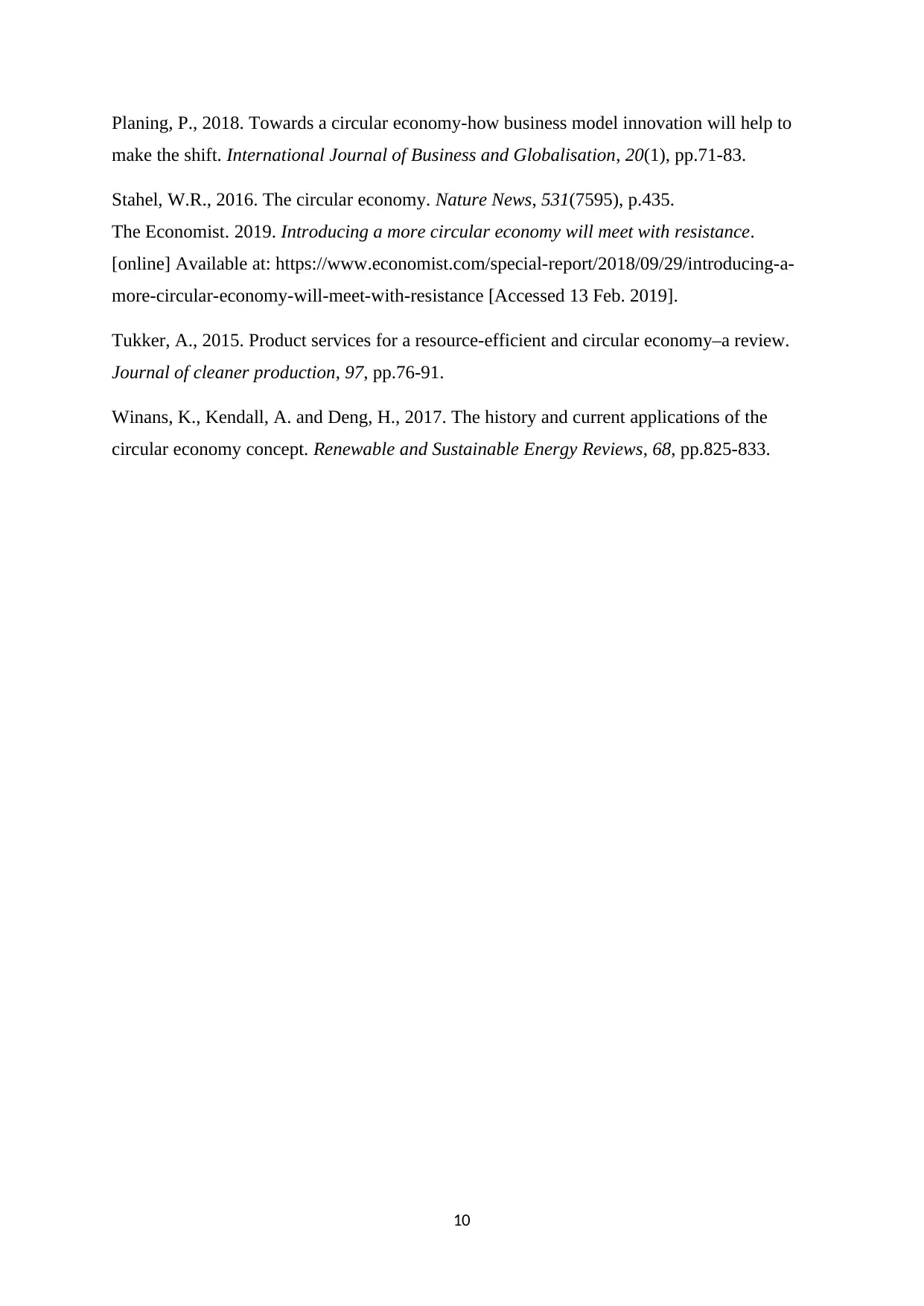
Planing, P., 2018. Towards a circular economy-how business model innovation will help to
make the shift. International Journal of Business and Globalisation, 20(1), pp.71-83.
Stahel, W.R., 2016. The circular economy. Nature News, 531(7595), p.435.
The Economist. 2019. Introducing a more circular economy will meet with resistance.
[online] Available at: https://www.economist.com/special-report/2018/09/29/introducing-a-
more-circular-economy-will-meet-with-resistance [Accessed 13 Feb. 2019].
Tukker, A., 2015. Product services for a resource-efficient and circular economy–a review.
Journal of cleaner production, 97, pp.76-91.
Winans, K., Kendall, A. and Deng, H., 2017. The history and current applications of the
circular economy concept. Renewable and Sustainable Energy Reviews, 68, pp.825-833.
10
make the shift. International Journal of Business and Globalisation, 20(1), pp.71-83.
Stahel, W.R., 2016. The circular economy. Nature News, 531(7595), p.435.
The Economist. 2019. Introducing a more circular economy will meet with resistance.
[online] Available at: https://www.economist.com/special-report/2018/09/29/introducing-a-
more-circular-economy-will-meet-with-resistance [Accessed 13 Feb. 2019].
Tukker, A., 2015. Product services for a resource-efficient and circular economy–a review.
Journal of cleaner production, 97, pp.76-91.
Winans, K., Kendall, A. and Deng, H., 2017. The history and current applications of the
circular economy concept. Renewable and Sustainable Energy Reviews, 68, pp.825-833.
10
1 out of 10
Related Documents
Your All-in-One AI-Powered Toolkit for Academic Success.
+13062052269
info@desklib.com
Available 24*7 on WhatsApp / Email
![[object Object]](/_next/static/media/star-bottom.7253800d.svg)
Unlock your academic potential
Copyright © 2020–2025 A2Z Services. All Rights Reserved. Developed and managed by ZUCOL.





